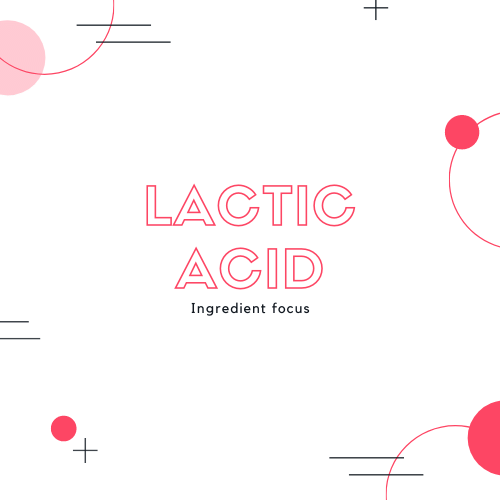(All references supporting the acid series are available at this LINK)
Introduction
Lactic Acid or 2-hydroxypropanoic acid is an AHA and is marginally larger than Glycolic Acid. Its commonly found in sour milk and tomato juice.
Structure
Glycolic Acid weighs 76g/mol and Lactic Acid weighs 90g/mol.

Lactic Acid is present in our bodies – its what your body produces when you run very fast and get that aching feeling within your muscle.
Lactic Acid as a Natural Moisturising Factor
The Stratum Corneum (SC) (topmost layer) of the skin has to remain hydrated, as otherwise, it will become a brittle structure that (e.g.) regularly allows foreign substances to pass through the skin.
One mechanism the SC has to maintain hydration levels is via Natural Moisturising Factors (NMFs). These are molecules (e.g.) ceramides, lipids, PCA and lactic Acid, that essentially hold water. Lactic Acid is a humectant – it basically helps the skin to hold water.
So, Lactic Acid is commonly used because of its moisturising properties as a humectant.
Benefits
Lactic Acid is quite unique: it gives the benefits of an alpha hydroxy acid as well as those of a Natural Moisturising Factor.
Lactic Acid has been used to ameliorate dry skin. Studies show an improvement in dry skin condition following twice daily application of 12% lactic acid.
It also improves the SC barrier and prevents skin irritation.
An 8% Lactic Acid formulation has been found to reduce the overall severity of photodamaged skin, mottled hyper-pigmentation, sallowness and skin roughness.
Lactic Acid is also a skin lightener: it reduces melanin synthesis by directly inhibiting the tyrosinase enzyme, causing the skin to become lighter.
Side Effects
In general, these are common side-effects (but as with benefits, these are not the only side-effects):
- Severe redness (erythema)
- Swelling
- Burning
- Skin discolouration
- Blistering
- Rash and Bleeding
- Post Inflammatory Hyper-pigmentation*
* PIH arises in Fitpatrick type IV, V and VI because of, “unpredictable response of melanocytes to injury that can cause disfiguring post-inflammatory change.”
In plain English, chemical peels can cause increased or severely reduced melanin production after the peel in a way that cannot be predicted. You can end up with more or less pigmentation then before the treatment….
Benefits
Lactic Acid is quite unique: it gives the benefits of an alpha hydroxy acid as well as those of a Natural Moisturising Factor. Also, it’s a skin whitener:
Lactic Acid has been used to ameliorate dry skin. Studies show an improvement in dry skin condition following twice daily application of 12% lactic acid.
It also improves the SC barrier and prevents skin irritation.
An 8% Lactic Acid formulation has been found to reduce the overall severity of photodamaged skin, mottled hyper-pigmentation, sallowness and skin roughness.
Lactic Acid is also a skin lightener: it reduces melanin synthesis by directly inhibiting the tyrosinase enzyme, causing the skin to become lighter.
The following should think of using this acid….
Owing to its moisturising properties, its ideal for treating dry skin but absolutely anyone can use it. However, it needs to be used in conjunction with an occlusive agent, as otherwise all the water will just evaporate away…
Lactic acid can be used to treat acne BUT Salicylic Acid is the preferred vehicle.
The following should not be using this acid
Despite Lactic Acid’s many benefits it can still have the same irritating effects as Glycolic Acid. Therefore, if you have generally have:
- Sensitive skin (including photo-sensitivity),
- Difficulties finding new products, because your skin reacts poorly
- Rosacea and so on, then you should give Lactic Acid a wide berth.
If you have dark skin (Fitzpatrick skin type IV, V or VI), you should Lactic Acid a wide berth.
Products for first time users?
Start with a low concentration and if the Lactic acid is under 1% than that’s a good start. Remember that if you want the NMF benefit of Lactic Acid you have to combine it with an occlusive – so just using Lactic Acid on a standalone basis will only get you so far…
